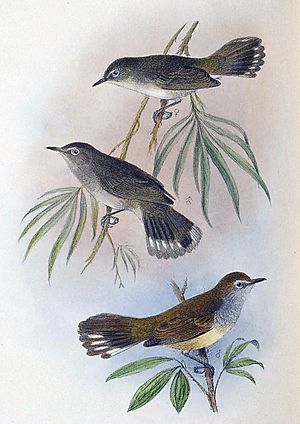Lord Howe gerygone facts for kids
Quick facts for kids Lord Howe gerygone |
|
|---|---|
 |
|
| Conservation status | |
| Scientific classification | |
| Genus: |
Gerygone
|
| Species: |
insularis
|
| Synonyms | |
|
|
The Lord Howe gerygone (Gerygone insularis) was a small, brownish-grey bird. It was also called the "Lord Howe gerygone flyeater." This bird had a bright yellow belly and lived in the tall trees of Lord Howe Island.
People on the island had special names for it. They called it the "rain-bird" because it was very active after it rained. Another nickname was "pop-goes-the-weasel" because its song sounded like the famous tune.
This bird was endemic to Lord Howe Island, meaning it lived nowhere else in the world. Lord Howe Island is in the Tasman Sea, off the coast of New South Wales, Australia. Sadly, no one has seen a Lord Howe gerygone since 1928. It is now considered extinct. Scientists believe it died out because of black rats that arrived on the island by accident in 1918.
Contents
About the Lord Howe Gerygone
What's in a Name?
Scientists have discussed the best way to classify the gerygone birds. The Lord Howe gerygone was first named Gerygone insularis by Ramsay in 1879. It was sometimes called Pseudogerygone insularis.
Some thought it might be a subspecies of other gerygone birds. These included G. modesta from Norfolk Island and G. igata from New Zealand.
Appearance and Size
The Lord Howe gerygone was a small songbird. It was mostly brown and grey. It had a light grey ring around its eyes. Its chin and throat were also light grey.
The bird's back and the top of its head were medium brown. Its chest was pale grey with a touch of yellow. The belly was bright yellow. The tail was brown on top, turning black at the tip, and white underneath.
This bird had pink eyes, similar to an albino rat. It also had a thin, grey beak. On average, the Lord Howe gerygone was about 12 centimeters (about 4.7 inches) long. It weighed only 6 to 7 grams (about 0.2 ounces). Its small size and thin beak were perfect for catching tiny insects.
Life and Behavior
Reproduction and Nests
Female Lord Howe gerygones would lay a clutch of three eggs. These eggs were pinkish with brown speckles. The birds built domed nests. They used dry bark, plant fibers, leaves, grass, moss, and wool. They held it all together with spider webs.
These nests hung from twigs. Local people described the nests as having an entrance on the side with a small hood over it.
Diet and Food
The Lord Howe gerygone mainly ate small insects and spiders. Its thin beak helped it pull these tiny creatures from the trees. They were especially good at finding food after it rained. This was because more small insects were around during wet weather.
Habitat and Home
This bird lived only on Lord Howe Island in Australia. It was a very common bird there. It lived mostly in the canopies of the island's native forests. It also lived in areas where new forests were growing back.
Why the Lord Howe Gerygone Disappeared
Extinction of the Species
The Lord Howe gerygone has not been seen alive since 1928. It is believed to be extinct. The main reason for its disappearance was the arrival of black rats on the island.
In 1918, a ship called the SS Makambo was shipwrecked near Lord Howe Island. Black rats got off the ship and onto the island. These rats preyed on the bird's nests, eating the eggs and young birds. This caused the population of the Lord Howe gerygone to drop quickly until they were all gone.
See also
 In Spanish: Gerygone insularis para niños
In Spanish: Gerygone insularis para niños


